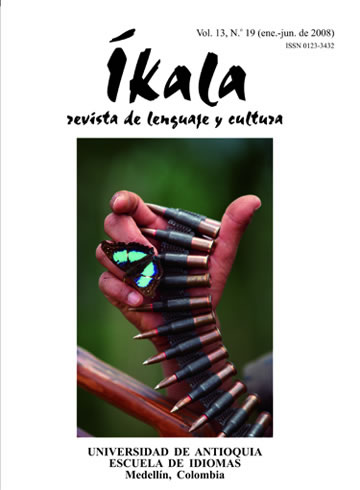La influencia entre lenguas en su adquisición multilingüe: el papel de L1 y de lenguas no nativas en la producción oral en inglés y en catalán
DOI:
https://doi.org/10.17533/udea.ikala.2694Palabras clave:
clave, influencia interlingüística, adquisición de terceras lenguas, hablante plurilingüe, transferencia léxica, transferencia sintácticaResumen
Gran parte de la investigación en la adquisición de terceras lenguas se ha centrado en los efectos que tienen factores como la distancia entre lenguas, la competencia, el uso reciente, o el estatus de la segunda lengua (L2) en la elección de la lengua origen (L1) desde el punto de vista de la influencia interlingüística. Se presenta aquí un análisis de dichos factores, así como la influencia que tiene la L1 (español) en la producción oral en L2 (inglés) y L3 (catalán). Se analiza la transferencia léxica y sintáctica en la producción en catalán e inglés de dos hablantes plurilingües con conocimiento similar de lenguas extranjeras. Fueron entrevistados dos veces en un ambiente informal. Los resultados muestran que la L1 es la principal fuente de transferencia, tanto en la producción oral en L2, como en L3; pero su influencia disminuye a medida que la competencia en la lengua meta incrementa. La distancia entre lenguas también tiene un papel importante en la influencia interlingüística, especialmente si la competencia en la lengua de origen es buena, y si ha habido un contacto reciente con ella. Los resultados también sugieren que mientras que la transferencia sintáctica se basa exclusivamente en la L1, la transferencia léxica se puede basar en la lengua no nativa.
Recibido: 16-11-2007 /Aceptado: 11-02-2008
Cómo referenciar este artículo:
Ortega, Mireia. (2008). Cross-linguistic influence in multilingual language acquisition: The role of L1 and non-native languages in English and Catalan oral production. Íkala. 13(1), pp.121-142.
Descargas
Citas
Bild, E.R. and Swain, M. (1989). Minority language students in a French immersion programme: their French proficiency. Journal of Multilingual and Multicultural Development, 10, 255-74.
Celaya, M.L. and Torras, R. (2001). L1 influence and EFL vocabulary: Do children rely more on L1 than adult learners? Proceedings of the 25 AEDEAN Conference. Granada.
Cenoz, J., Hufeisen, B. And Jessner, U. (2001). Cross-linguistic Influence in Third Language Acquisition: Psycholinguistic Perspectives. Clevedon: Multilingual Matters.
Cenoz, J. (2001). The effect of linguistic distance, L2 status and age on cross-linguistic influence in third language acquisition. In J. Cenoz, B. Hufeisen & U. Jessner (eds.), Crosslinguistic Influence in Third Language Acquisition: Psycholinguistic Perspectives (pp. 8-20). Clevedon: Multilingual Matters.
Chomsky, N. (1959). Review of Verbal Behaviour by B.K. Skinner. Language, 35, 26-58.
Cook, V. (1995). Multi-competence and the learning of many languages. Language, Culture and curriculum, 8, 93-8.
De Angelis, G. and Selinker, L. (2001). Interlanguage transfer and competing linguistic systems in the multilingual mind. In
J. Cenoz, B. Hufeisen & U. Jessner (eds.), Cross-linguistic Influence in Third Language Acquisition: Psycholinguistic Perspectives (pp. 42-58). Clevedon: Multilingual Matters.
Dewaele, J-M. (1998). Lexical inventions: French interlanguage as L2 versus L3. Applied Linguistics, 19, 471-490.
Dewaele, J-M. (2001). Activation or inhibition? The interaction of L1, L2 and L3 on the language mode continuum. In J.
Cenoz, B. Hufeisen & U. Jessner (eds.), Cross-linguistic Influence in Third Language Acquisition: Psycholinguistic Perspectives (pp. 69-89). Clevedon: Multilingual Matters.
Ellis, R. (1985). Understanding Second Language Acquisition. Oxford: Oxford University Press.
Grosjean, F. (1992). Another view of bilingualism. In R.J. Harris (ed.), Cognitive Processing in Bilinguals (pp. 51-62). Amsterdam: North Holland.
Grosjean, F. (1998). Studying bilinguals: Methodological and conceptual issues. Bilingualism: Language and Cognition, 1, 131-49.
Hammarberg, B. (2001). Roles of L1 and L2 in L3 production and acquisition. In J. Cenoz, B. Hufeisen & U. Jessner (eds.), Cross-linguistic Influence in Third Language Acquisition: Psycholinguistic Perspectives (pp. 21-41). Clevedon: Multilingual Matters.
Jessner, U. (1999). Metalinguistic awareness in multilinguals: Cognitive aspects of third language learning. Language Awareness, 8, 3&4: 201-9.
Kellerman, E. (1983). Now you see it, now you don't. In S. Gass and L. Selinker (eds.), Language Transfer in Language Learning (pp. 112-34). Rowley, MA: Newbury House.
Kellerman, E. (1984). The empirical evidence for the influence of the L1 in interlanguage. In A. Davies et al. (eds.), Interlanguage. Edinburgh: Edinburgh University Press.
Manchón, R.M. (2001). Un acercamiento psicolingüístico al fenómeno de la transferencia en el aprendizaje y uso de segundas lenguas. In S. Pastor & V. Salazar (eds.), Estudios de lingüística (pp. 39-72). Alicante: Universidad de Alicante.
Odlin, T. (1989). Language Transfer. Cross-Linguistic Influence in Language Learning.
Cambridge: Cambridge University Press. Odlin, T. and Jarvis, S. (2004). Same source, different outcomes: A study of Swedish influence on the acquisition of English in Finland. The International Journal of Multilingualism 1, 2, 123-140.
Ringbom, H. (1986). Crosslinguistic influence and the foreign language learning process. In El. Kellerman & Shardwood Smith (eds.), Crosslinguistic Influence in Second Language Acquisition (pp. 150-62). New York: Pergamon Press.
Ringbom, H. (1987). The Role of the First Language in Foreign Language Learning. Clevedon: Multilingual Matters.
Ringbom, H. (2001). Lexical transfer in L3 production. In J. Cenoz, B. Hufeisen & U. Jessner (eds.), Cross-linguistic Influence in Third Language Acquisition: Psycholinguistic Perspectives (pp. 59-68). Clevedon: Multilingual Matters.
Ringbom, H. (2006). The importance of different types of similarity in transfer studies. In J. Arabski (eds.), Cross-linguistic Influences in the Second Language Lexicon (pp. 36-45). Clevedon: Multilingual Matters.
Navés, T., Miralpeix, I. and Celaya, M.L. (2005). Who transfers more... and what? Crosslinguistic influence in relation to school grade and language dominance in EFL. International Journal of Multilingualism, 2, 2, 1-22.
Thomas, J. (1992). Metalinguistic awareness in second – and third – language learning. In R.J. Harris (ed.), Cognitive Processing in Bilinguals (pp. 531 – 45). Amsterdam: North Holland.
Tremblay, M. (2006). Cross-linguistic influence in third language acquisition: The role of L2 proficiency and L2 exposure. CLO/OPL, 34, 109-119.
Williams, S and Hammarberg, B. (1998). Language switches in L3 production: Implications for a polyglot speaking model. Applied Linguistics 19, 295 – 333.
Descargas
Publicado
Cómo citar
Número
Sección
Licencia
Derechos de autor 2008 Íkala, Revista de Lenguaje y Cultura

Esta obra está bajo una licencia internacional Creative Commons Atribución-NoComercial-CompartirIgual 4.0.












